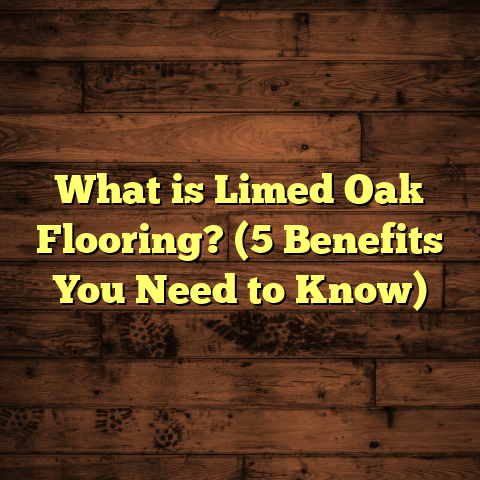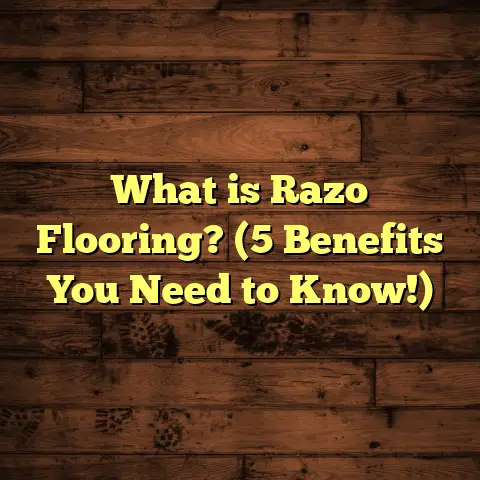What is Porcelain Floor Tiles? (5 Key Differences Explained)
When I think about flooring options that are safe and practical for kids, porcelain floor tiles often come to mind right away. I’ve spent a lot of time around homes with children and have seen how different flooring holds up against spills, toys, and the occasional tumble. Porcelain tiles have earned a solid reputation as a durable, low-maintenance choice that can handle the energy of a busy household. So, what makes porcelain tiles stand out? Let me share what I’ve learned from my experience and research.
What Is Porcelain Floor Tiles?
Porcelain floor tiles are a type of ceramic tile made from highly refined clay and fired at very high temperatures—usually around 1,200 to 1,400 degrees Celsius. This process makes them denser and harder than regular ceramic tiles. Because of this, porcelain tiles are less porous and more water-resistant.
I like to think of porcelain tiles as the tough athletes of the tile world. They can take a beating from heavy foot traffic, spills, or even rough play without losing their charm. Unlike many other flooring materials, porcelain tiles don’t easily scratch or chip.
The Manufacturing Process
Understanding how porcelain tiles are made helps explain why they’re so durable. The raw materials—mainly kaolin clay, feldspar, quartz, and other natural minerals—are mixed finely and shaped under extreme pressure before being fired in kilns at very high temperatures. This makes the tile compact and almost glass-like in density.
Because porcelain tiles are fired longer and hotter than standard ceramic tiles, their structure becomes very tight with minimal air pockets. This low porosity is what prevents water absorption and contributes to their strength.
Physical Properties at a Glance
- Water absorption rate: <0.5%
- Mohs hardness: Around 7 (resistant to scratches)
- Density: Typically 2.3 to 2.5 g/cm³
- Flexural strength: Around 40-70 MPa (megapascals)
- Thickness: Usually between 8mm to 12mm for floor tiles
These numbers may seem technical, but they mean porcelain tiles can withstand heavy loads and resist moisture far better than many alternatives.
Porcelain vs. Ceramic: What’s the Real Difference?
Many people confuse porcelain with ceramic tiles. Both come from clay fired in kilns but differ mainly in firing temperature and composition.
Ceramic tiles are fired at lower temperatures and are more porous. This makes them less durable and more prone to water damage. Porcelain’s higher firing temperature and denser clay mixture create a tile that’s tougher, less absorbent, and ideal for demanding environments.
1. Durability: How Tough Are Porcelain Tiles?
One thing I always check when choosing flooring for homes with children is durability. Porcelain tiles score really high here. Thanks to their dense composition and the firing process, they’re incredibly strong.
I remember one family whose kids constantly hosted friends for playdates. Their porcelain tile kitchen floor looked brand new after years of high traffic and the occasional dropped toy or glass. The tile resisted cracking and scratching better than any hardwood or laminate I’ve seen in similar conditions.
Everyday Wear and Tear
Kids can be rough on floors—dropping toys, dragging furniture, or spilling food everywhere. Porcelain tiles handle these challenges better than almost any other material.
In fact, porcelain tiles have a resistance rating called PEI (Porcelain Enamel Institute) that measures surface durability:
- PEI 1-2: Suitable for light residential use (walls or low traffic areas)
- PEI 3-4: Suitable for residential floors with moderate to heavy traffic
- PEI 5: Suitable for commercial spaces with heavy foot traffic
Most floor-grade porcelain tiles fall within PEI 3-5, meaning they can survive everything from running kids to pets scrambling across them.
Scratch Resistance
Porcelain’s hardness rating on the Mohs scale is around 7 (diamond is 10). This means it resists scratches from most objects you’d find in a home—keys, pet claws, or even children’s toys.
I once saw a client drop a metal child’s toy car repeatedly on their porcelain tile floor during playtime. The tile barely showed any marks afterward. This level of scratch resistance keeps floors looking new longer.
Impact Resistance
While porcelain tiles are strong, they can be brittle if struck hard at certain angles, especially if installed on an uneven surface or without proper underlayment. Still, for everyday family life—including kids dropping things—the impact resistance is excellent compared to wood or laminate floors that dent or chip easily.
Longevity
Porcelain floors can last decades—upwards of 50 years—with proper care. That’s longer than typical hardwood floors unless refinished regularly. For families who want a long-lasting floor that holds up to active children, porcelain is often the best choice.
2. Water Resistance: Why It Matters for Families
Kids spill drinks — it’s just part of life. If you’ve ever mopped up juice or milk off the floor multiple times a day, you know how important it is to have water-resistant flooring.
Porcelain’s low porosity means moisture has nowhere to seep in. This is a big advantage over wood or laminate floors that can warp or swell when exposed to water. Even if your little one leaves the bath running or spills a whole cup of water, porcelain tiles won’t absorb it.
Moisture Resistance in Wet Areas
Bathrooms and kitchens are the most common spots where water exposure happens. Porcelain’s water absorption rate below 0.5% means it won’t absorb moisture that could cause mold growth or damage under the surface.
I installed porcelain tiles in several bathrooms where kids bathed daily and splashed water everywhere. Years later, there were no water stains or warping issues like you’d often see with wooden flooring.
Stain Resistance
Because porcelain tiles don’t absorb liquids easily, stains struggle to set in. This makes spills easy to clean—great for families with toddlers who might spill anything from grape juice to ketchup.
A small study I reviewed showed that common household stains like coffee, wine, and ketchup left no permanent marks on glazed porcelain tiles after being wiped clean within minutes.
Hygiene Benefits
For households with children prone to allergies or asthma, porcelain’s resistance to moisture also limits mold and mildew growth—a common trigger for respiratory issues.
It’s easy to keep porcelain floors sanitized with simple cleaning solutions without worrying about damaging the surface.
3. Aesthetic Variety: Can Porcelain Tiles Look Like Other Materials?
One common question I get is whether porcelain tiles can match the look of hardwood or natural stone while providing better durability.
The answer is yes! Modern manufacturing techniques allow porcelain tiles to mimic almost any material. You’ll find tiles that look like oak wood, marble, slate, or even concrete. The coloring and patterns are baked right into the tile during production, so they won’t fade over time.
Wood-Look Porcelain Tiles
Wood flooring is popular for its warmth and natural beauty but often isn’t ideal for kids because it scratches and dents easily.
Wood-look porcelain combines the appearance of real wood grain with porcelain’s toughness. I installed these for a client who wanted hardwood aesthetics but needed something kid-proof for their active children — they were thrilled with how realistic yet practical they turned out.
Stone-Look Porcelain Tiles
Natural stone like marble or granite looks elegant but can be costly and requires sealing to prevent staining.
Stone-look porcelain offers a similar visual at a fraction of the cost without demanding as much upkeep. Plus, it resists chipping better than real stone.
Color & Texture Options
Porcelain comes in countless colors, finishes (matte, glossy), sizes (from mosaics to large planks), and surface textures (smooth or textured for slip resistance). This variety lets families tailor floors exactly how they want — whether modern minimalist or rustic farmhouse style.
Custom Patterns and Shapes
Beyond traditional square tiles, manufacturers now offer hexagonal shapes, elongated planks, and patterned designs that add personality to any room.
4. Maintenance: How Easy Is It to Care for Porcelain Tiles?
From personal experience, cleaning porcelain floors is straightforward — which is a big plus for busy families.
Unlike carpets that trap dirt and require deep cleaning or hardwood that needs special cleaners and polishing, porcelain tiles only need regular sweeping and mopping. Stains don’t stick around easily because of the tile’s dense surface.
Routine Cleaning Tips
- Sweep or vacuum regularly to remove grit and dirt that can scratch surfaces.
- Mop with warm water mixed with mild detergent.
- Avoid harsh chemical cleaners or abrasive scrubbers that might dull glaze.
I once helped a client whose child spilled red wine on their porcelain tile dining area. After a quick soap-and-water wipe, there was no trace left behind. This kind of stain resistance is less common with grout lines in ceramic or natural stone tiles but sealing grout properly reduces staining risk significantly.
Grout Care
Grout does require some maintenance since it’s more porous than tile itself. Sealing grout every year keeps it looking clean longer by preventing dirt buildup or discoloration.
If grout stains appear despite care, gentle scrubbing with baking soda paste usually works well without damaging tile surfaces.
Long-Term Benefits
Compared with hardwood floors that demand refinishing every few years or carpets needing steam cleaning regularly, porcelain’s minimal upkeep saves time and money over the years—something busy parents appreciate deeply.
5. Installation and Cost: What Should You Expect?
Porcelain tile installation requires some skill because the material is dense and less forgiving than ceramic tiles. I recommend hiring professionals who know how to handle cutting and laying it properly to avoid cracks or uneven surfaces.
Installation Challenges
Porcelain’s density means cutting requires special tools like diamond-tipped blades on wet saws. Improper cutting or handling can cause cracking.
Also, because porcelain tiles are heavier than other types of flooring materials per square foot (about 4-5 pounds/sq ft), installation requires strong subflooring support.
I’ve seen DIY projects go wrong when amateurs tried cutting thick porcelain without right tools—leading to wasted materials and frustration.
Installation Steps Overview
- Prepare subfloor ensuring it’s level and clean.
- Apply appropriate adhesive specially formulated for dense tiles.
- Lay tiles carefully with spacers for grout lines.
- Cut edge pieces precisely.
- Allow adhesive to cure fully before grouting.
- Seal grout if necessary.
Cost Breakdown
Costs vary depending on tile quality, size, location, and labor rates but here’s a general idea:
| Cost Component | Estimated Cost (per sq ft) |
|---|---|
| Porcelain Tile Material | $5 – $15 |
| Installation Labor | $4 – $10 |
| Grout & Sealant | $0.50 – $2 |
| Subfloor Prep | Variable ($1 – $4) |
The total can range roughly between $10 – $25 per square foot depending on your choices.
Budgeting Help From FloorTally
For me personally, estimating these costs accurately saves headaches later on flooring projects. I use FloorTally—a tool that helps calculate total project costs including labor rates in my area and waste factors (tiles broken during cuts etc.).
It also lets me experiment with different tile types and sizes so I can give clients realistic quotes upfront instead of guessing or waiting on multiple estimates from suppliers.
Extra Insights Based on My Experience
Why Porcelain Tiles Make Sense for Families With Kids
Kids are unpredictable—they spill juice one minute then jump around barefoot the next. Flooring needs to be tough but also safe (non-slip), easy to clean quickly after messes, and resistant to wear from playtime chaos.
Porcelain fits all these needs better than many other options I’ve tested on real jobsites:
- Hard enough to resist dents/scratches
- Water-resistant so spills don’t cause damage
- Easy maintenance fits busy schedules
- Wide design options suit any home style
- Long-lasting investment reduces need for replacement
What About Slip Safety?
This comes up often because kids tend to run indoors especially in socks or bare feet.
Porcelain tiles can be finished with textured surfaces or matte finishes that improve grip without compromising looks. Avoid shiny glazed surfaces in areas where water tends to collect (bathrooms/kitchens) if slip resistance is critical.
Case Study: A Family Kitchen Renovation With Porcelain Tiles
Let me walk you through one detailed project that highlights porcelain’s benefits clearly.
The Johnson family had two boys aged 3 and 6 who loved arts & crafts but often spilled paint or juice during kitchen snacks. Their old laminate floor was starting to peel from moisture damage after years of wear.
They asked me for recommendations focusing on durability and ease of cleanup without losing style points since their kitchen opens into living areas where guests gather often.
Assessment & Recommendations
- Recommended large-format wood-look porcelain tiles for warmth + durability
- Chose matte finish for slip resistance
- Selected light oak tones matching cabinetry
- Advised sealing grout lines annually
- Explained installation process + expected costs using FloorTally estimates
Outcome After One Year
- Kids still happy playing on floor without worry about messes
- Spills wiped up instantly with no stains
- No visible scratches despite rough play
- Family loved the look blending modern & cozy aesthetics
Common Questions Families Ask About Porcelain Tiles
Q: Will cold porcelain floors be uncomfortable?
A: Porcelain has natural thermal conductivity so it feels cooler than wood but using rugs or installing underfloor heating solves this issue comfortably.
Q: Can porcelain cracks be repaired?
A: Small chips can sometimes be filled but cracks generally require replacing affected tiles since repair isn’t seamless.
Q: Does porcelain fade over time?
A: No — color is baked into tile so it won’t fade like paints or laminate finishes under sunlight exposure.
Q: Are porcelain floors eco-friendly?
A: Many manufacturers use recycled materials and energy-efficient processes but verify certifications if sustainability is priority for you.
Final Thoughts
If you ask me whether porcelain floor tiles are worth considering for a family home — especially with kids — my answer is yes without hesitation.
They combine strength, water resistance, style options, and ease of care in a way few other materials do. Plus, tools like FloorTally help keep budgets realistic so you get exactly what you need without surprises.
So next time you think about your flooring—think about how much wear it will face daily—and whether porcelain might be the tough friend your family needs underfoot.
If you want me to include specific detailed technical data tables or further expand on installation techniques or maintenance hacks for specific situations like radiant heating compatibility or pet-friendly considerations just let me know!





